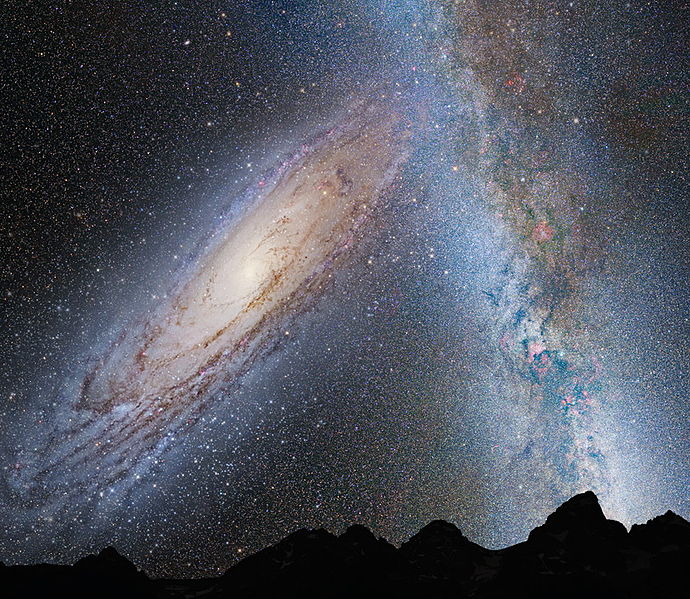A formação da nossa casa galáxia Milky Way began 12 billion years ago. Since then, it has undergone a sequence of mergers with other galaxies and grew in mass and size. The remnants of building blocks (i.e., galaxies that merged with the Miky Way in the past) can be identified through their unusual values for energy and angular momentum and low metallicity. The two earliest building blocks of our home galáxia have recently been identified using Gaia dataset and have been named Shiva and Shakti after Hindu deities. Gaia espaço telescope which is dedicated to the study of our home galaxy has revolutionised the study of Milky Way. Gaia Enceladus/ Sausage stream, the Pontus stream and the “poor old heart” of the Milky Way were identified earlier using Gaia dataset. The history of Milky Way is replete with mergers. Hubble Espaço Telescope images suggest that six billion years from now, our home galaxy will merge with the neighbouring Andromeda galaxy.
Galáxias e outras grandes estruturas formadas no universo cerca de 500 milhões de anos após o Big Bang.
A formação da nossa casa galáxia A Via Láctea começou há cerca de 12 bilhões de anos. Desde então, passou por uma sequência de fusões com outras galáxias que contribuíram para o seu crescimento em massa e tamanho. A história da Via Láctea é essencialmente a história da fusão de outras galáxias com a nossa galáxia natal.
The basic properties of the estrelas like energy and angular momentum are directly linked to the speed and direction of the galáxia of origin and are shared between the stars of the same galaxy. When galaxies merge, energy and angular momentum remain conserved over time. This serves as a key tool in identification of a merger remnant. A large group of estrelas with similar unusual values of energy and angular momentum are likely to be a merger remnant of a galaxy. Also, the older stars have low metallicity, i.e., stars that formed earlier have low metal contents. Based on these two criteria, it is possible to trace merger history of the Milky Way however it would not have been possible without the Gaia datasets.
Launched by ESA on 19 December 2013, Gaia espaço telescope is dedicated to the study of Milky Way including its origin, structure and evolutionary history. Parked in Lissajous órbita around L2 Lagrange point (located approximately 1.5 million km from Earth in the direction opposite the Sun) along JWSTName and Euclid spacecrafts, Gaia probe is conducting a huge stellar census covering about 1.5 billion stars in the Milky Way recording their motions, luminosity, temperature and composition and creating a precise 3D map of the home galáxia. Hence, Gaia is also referred as billion-star surveyor. The datasets generated by Gaia has revolutionized study of history Milky Way.
In 2021, using Gaia datasets, astronomers learnt of a major merger and identified Gaia Enceladus/Sausage stream, the remnant of Gaia-Sausage-Enceladus (GSE) galáxia that merged with the Milky Way between 8 and 11 billion years ago. Subsequently, Pontus stream and “poor old heart” of the Milky Way were identified the following year. The Pontus stream is the remnant of Pontus merger while “poor old heart” is estrela group that formed during the initial mergers that created the proto-Milky Way and continue to reside in the central region of Milky Way.
Now, astronomers report discovery of two streams of estrelas that formed and merged with an early version of our Milky Way between 12 and 13 billion years ago, around the time when galaxies were forming in the early Universo. Para isso, os pesquisadores combinaram dados de Gaia com espectros estelares detalhados do Sloan Digital Sky Survey (DR17) and observed that stars were crowded around two specific combinations of energy and angular momentum for a certain range of low-metal stars. The two groups had angular momentum similar to the stars that had been part of separate galaxies which merged with the Milky Way. Perhaps, the earliest building blocks of the Milky Way, the researchers have named them Shiva and Shakti after the Hindu deities. It is possible that the newly discovered star groups were first to merge with the ‘poor old heart’ of our Milky Way and the story towards a large galáxia began. Future studies should confirm if Shiva and Shakti are indeed part of prehistory of Milky Way.
O que acontecerá com nossa galáxia natal no futuro?
Evolutionary history of Milky Way is replete with mergers. Hubble Espaço Telescope images suggests that six billion years from now, our home galaxy will merge with the neighbouring Andromeda galaxy situated at 2.5 million light-years away to give rise to a new galaxy. Andromeda will collide with the Milky Way at 250,000 mph about 4 billion years from now. The clash between the two galaxies will last for 2 billion years giving rise to a combined elliptical galaxy.
The solar system and the Earth will survive but will have new coordinates in espaço.
***
Referências:
- Naidu RP, et al 2021. Reconstruindo a última grande fusão da Via Láctea com a pesquisa H3. The Astrophysical Journal, Volume 923, Número 1. DOI: https://doi.org/10.3847/1538-4357/ac2d2d
- Malhan K., et al 2022. O Atlas Dinâmico Global das Fusões da Via Láctea: Restrições das Órbitas de Aglomerados Globulares, Fluxos Estelares e Galáxias Satélites baseadas em Gaia EDR3. Publicado em 17 de fevereiro de 2022. The Astrophysical Journal, Volume 926, Número 2. DOI: https://doi.org/10.3847/1538-4357/ac4d2a
- Malhan K. e Rix H.-W., 2024. 'Shiva e Shakti: supostos fragmentos protogalácticos na Via Láctea Interna. O Jornal Astrofísico. Publicado em 21 de março de 2024. DOI: https://doi.org/10.3847/1538-4357/ad1885
- Instituto Max Planck de Astronomia (MPIA). Notícias – Pesquisadores identificam dois dos primeiros blocos de construção da Via Láctea. Disponível em https://www.mpia.de/news/science/2024-05-shakti-shiva?c=5313826
- Schiavi R. etudo 2021. Futura fusão da Via Láctea com a galáxia de Andrômeda e o destino de seus buracos negros supermassivos. Pré-impressão no arXiv. DOI: https://doi.org/10.48550/arXiv.2102.10938
***






































